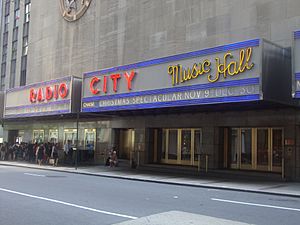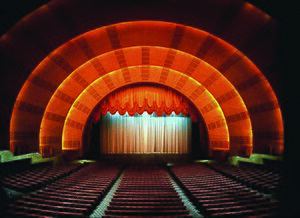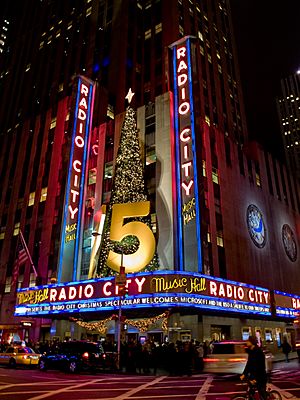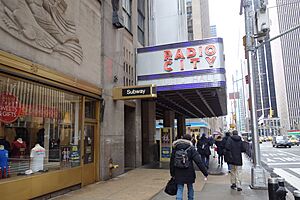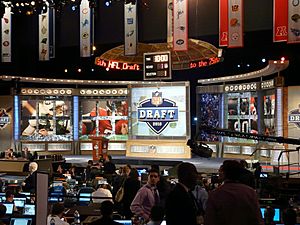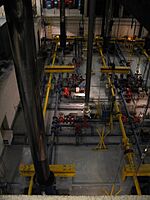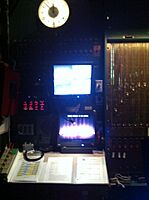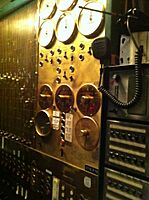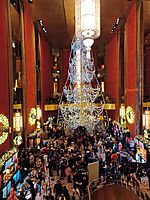Radio City Music Hall facts for kids
|
"The Showplace of the Nation"
|
|
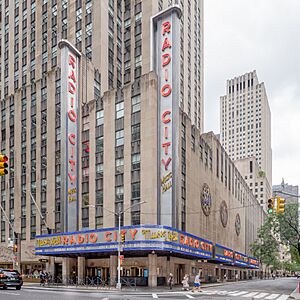
Radio City Music Hall in 2021
|
|
| Location | 1260 Avenue of the Americas (Sixth Avenue) Manhattan, New York |
|---|---|
| Coordinates | 40°45′35″N 73°58′45″W / 40.75972°N 73.97917°W |
| Owner | Tishman Speyer Properties |
| Operator | Madison Square Garden Entertainment |
| Type | Concert hall, entertainment venue |
| Seating type | Raked |
| Capacity | 5,960 |
| Opened | December 27, 1932 |
|
Radio City Music Hall
|
|
|
U.S. Historic district
Contributing property |
|
| Area | 2 acres (0.8 ha) |
| Architect | Edward Durell Stone Donald Deskey |
| Architectural style | Art Deco |
| Part of | Rockefeller Center (ID87002591) |
| NRHP reference No. | 78001880 |
| Significant dates | |
| Added to NRHP | May 8, 1978 |
| Designated CP | December 23, 1987 |
Radio City Music Hall is a famous entertainment venue in New York City. It is located at 1260 Avenue of the Americas in Midtown Manhattan, as part of Rockefeller Center. The theater is nicknamed "The Showplace of the Nation" and is home to the famous dance group, the Rockettes. It was designed in the Art Deco style by Edward Durell Stone and Donald Deskey.
The land was first planned for a new opera house, but those plans were canceled in 1929. Instead, Radio City Music Hall was built and opened on December 27, 1932. With 5,960 seats, it was the world's largest theater auditorium when it opened. The name "Radio City" came from one of its first tenants, the Radio Corporation of America (RCA).
For many years, the theater showed movies along with live stage shows. It hosted the premieres of famous films like King Kong (1933), Mary Poppins (1964), and The Lion King (1994). By the 1970s, the theater was losing money and was in danger of closing. In 1978, it was saved by being named a New York City Landmark.
Today, Radio City Music Hall hosts concerts, stage shows like the Radio City Christmas Spectacular, and major televised events. These include the Grammy Awards, Tony Awards, and the MTV Video Music Awards.
Contents
History
Planning and Building
The land for Rockefeller Center was originally meant for a new home for the Metropolitan Opera. But after the stock market crash of 1929, the opera house project was canceled. John D. Rockefeller Jr. decided to build a media complex with theaters instead.
A theater operator named Samuel Roxy Rothafel was brought in to help. He planned a huge 6,200-seat theater for live shows. He wanted it to be bigger and better than his other theater, the Roxy Theatre. He had specific ideas for the design, like having three balconies instead of one big one, so everyone had a good view. He also wanted a special stage that could be changed quickly for different acts.
The architects designed the building in the popular Art Deco style. They used Indiana Limestone for the outside to match the other Rockefeller Center buildings. Inside, designer Donald Deskey used modern materials like glass, aluminum, and chrome. He also hired artists to create special furniture, carpets, and murals for the theater.
Construction began in December 1931. The theater opened on December 27, 1932. The opening night show was very long and not well-received by critics. One reporter called it "the world's best 'bust'". However, everyone loved the theater's beautiful design.
A Famous Movie Palace
Just two weeks after opening, the theater changed its plan. It began showing movies along with a live stage show. This format was a huge success. The first movie shown was The Bitter Tea of General Yen. Radio City became the place for major movie premieres from the RKO-Radio studio.
Famous movies that opened at Radio City include King Kong (1933), Snow White and the Seven Dwarfs (1937), and Breakfast at Tiffany's (1961). At its peak, the theater presented four complete performances every day.
The theater was very popular through the 1940s and 1950s. Lines for the Christmas show often wrapped around the block. Even as other big theaters in New York City closed, Radio City remained successful. By its 30th anniversary in 1962, nearly 200 million people had visited.
Hard Times and a Big Save
By the 1970s, things began to change. Fewer people were coming to the theater. It became harder to get family-friendly movies to show. The theater started losing a lot of money. In 1978, the owners announced that Radio City Music Hall would close.
This news caused a public outcry. A group called the Showpeople's Committee to Save Radio City Music Hall was formed. The Rockettes protested, and people from all over sent messages to save the theater. The New York City Landmarks Preservation Commission stepped in. They declared the theater's interior a city landmark, which protected it from being changed or torn down.
The theater was saved just hours before it was set to close. It was also added to the National Register of Historic Places. After a brief closure for cleaning and repairs, it reopened in 1979. The old format of a movie plus a stage show ended. The theater began to focus on concerts and other live events.
A New Era
In the 1980s, Radio City started producing its own concerts and shows. This new direction was very successful. By 1985, the theater made a profit for the first time in 30 years. It also became a popular venue for big awards shows like the Grammy Awards and Tony Awards.
In 1999, the theater closed for a major renovation. Everything from the seats and carpets to the famous gold curtain was restored or replaced. The goal was to bring the theater back to its original 1930s glory while adding modern technology. The $70 million project was a success, and the theater reopened with a gala concert.
In 2020, the theater closed temporarily due to the COVID-19 pandemic. It reopened in June 2021. That same year, a new rooftop park called Radio Park was opened on top of the theater.
Architecture
Radio City Music Hall is a masterpiece of the Art Deco style. This style is known for its clean lines, geometric shapes, and modern look.
Exterior
The outside of the theater features a huge marquee sign that wraps around the corner of Sixth Avenue and 50th Street. The name "Radio City Music Hall" shines in bright neon letters. Above the entrance are bronze plaques showing musicians and symbols for dance, drama, and song. These were made by artist Hildreth Meiere.
Interior
The inside of the theater is just as impressive as the outside. The Grand Foyer is a huge, four-story-tall space. It features a giant mural by Ezra Winter called "Quest for the Fountain of Eternal Youth." Two massive, tube-like chandeliers hang from the ceiling. A grand staircase sweeps up to the mezzanine levels.
The main auditorium is the heart of the theater. Its most stunning feature is the ceiling, which is made of eight arches that look like a sunrise or the northern lights. The stage is framed by a giant proscenium arch that is 60 feet high and 100 feet wide. The walls are covered in fabric with designs of performers.
The Great Stage itself is a mechanical wonder. It has three sections that can be raised and lowered, and a large turntable. The orchestra pit is on a platform that can be moved up to stage level or down to the basement. This advanced system was so impressive that the U.S. Navy used similar technology for its aircraft carriers during World War II.
Art and Design
The theater is filled with art from the 1930s. Designer Donald Deskey commissioned many artists to create works for the building.
- "Goose Girl" by Robert Laurent is an aluminum statue of a girl with a goose.
- "Eve" by Gwen Lux is another aluminum statue, located in the Grand Foyer.
- "Spirit of the Dance" by William Zorach is a third sculpture.
- The men's and women's lounges on each level have unique designs and murals by artists like Stuart Davis and Yasuo Kuniyoshi.
Famous Events
Radio City Music Hall has hosted many memorable events over the years.
Shows and Concerts
The Radio City Christmas Spectacular has been a holiday tradition since 1933. It stars the world-famous Rockettes. The Irish dance show Riverdance had its North American premiere here in 1996. Many famous musicians have performed on its stage, including The Grateful Dead, Liberace, and Adele.
Television and Sports
The theater has been a set for TV shows like Jeopardy! and Wheel of Fortune. From 2013 to 2015, the live shows for America's Got Talent were broadcast from Radio City.
The NFL Draft was held at the theater from 2006 to 2014. The New York Liberty basketball team even played some of their home games on a court set up on the stage in 2004.
Awards Ceremonies
Radio City is a popular place for major awards shows. The Tony Awards, which celebrate the best of Broadway theater, have been held here many times. The Grammy Awards and the MTV Video Music Awards have also used the famous venue for their ceremonies.
Gallery
See also
 In Spanish: Radio City Music Hall para niños
In Spanish: Radio City Music Hall para niños


